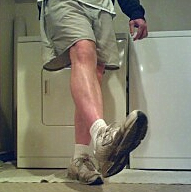1. Do You Have a Medical Reason Why You Shouldn’t Run?
There are very few medical conditions that rule out running. However, there are some people who shouldn’t run. For example, if you suffer from a bone or joint disorder then running may exacerbate the condition and cause pain.
Heart and lung conditions may also limit your ability to run. Speak with your doctor if you’re unsure about a current medical condition and your ability to run. In most cases, a running program can help reduce or alleviate health conditions.
| Running Shoes. (Photo credit: Wikipedia) |
Actually, all you really need to get started on a running program is a pair of well fitting running shoes. If you don’t have running shoes, spend some time trying on running shoes or visit a running store and talk with a specialist. Different types of shoes can compensate for any foot type, body mechanics or foot style.
3. Do You Have 10-30 Minutes a Day?
You don’t have to run for hours to reap the benefits. In fact, just running for ten minutes can provide you with better health and fitness. If you’re just starting out, it’s recommended that you start slowly. You can build up your endurance and distance over time.
4. Do You Have a Safe Place to Run?
The great thing about running is that you can do it in your living room on a treadmill, on the local track or around your neighborhood.
5. Do You Need/Want To Reduce Stress?
One of the surprising benefits of running is that it reduces stress. If you are looking for a way to relax and unwind, running may be the perfect solution.
6. Do You Want to Prevent Disease?
Running has been shown to reduce the risk of many killer diseases like heart disease, cancer, and diabetes. If you have a genetic tendency toward any of these diseases or you want to stay healthy and live a long life, running can help.
| JOG SHOT (Photo credit: whologwhy) |
Running, even for just a few minutes, releases endorphins. These lovely hormones, aka “Feel good” hormones, make you feel relaxed and joyful and the feelings can last for several hours. Couple that with the fact that running boosts metabolism and reduces stress and it’s a surefire way to have a more positive outlook.
Running isn’t for everyone but for most people, it can be a valuable addition to your lifestyle. Whether you want to become a competitive runner or simply run for pleasure, running can help you improve your health and fitness.















